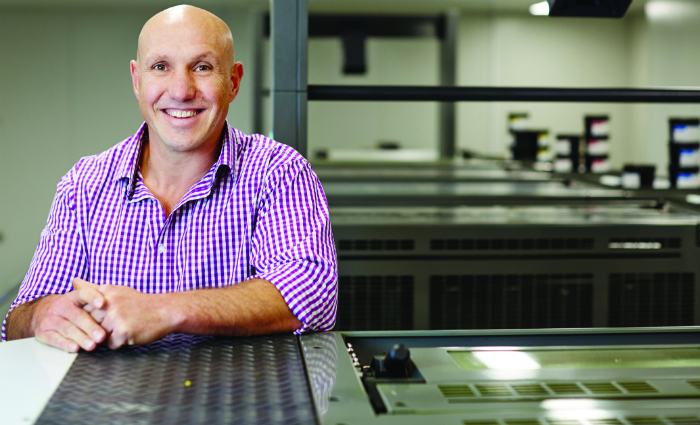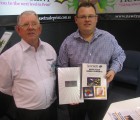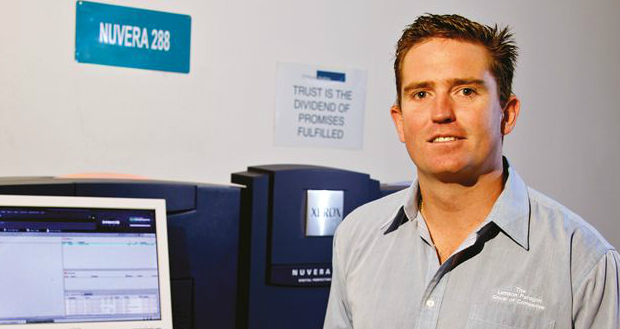
THIS IS A PROMOTIONAL ARTICLE PAID FOR BY WHIRLWIND
Andrew Cester first came face-to-face with print requirements as a consumer of the printed medium. As the owner of the Storm Club, a nightspot in Dandenong, he needed prestigious admission tickets printed but was unimpressed with the quality he was offered. Long story short, he and other family members ended up founding a graphic design agency. The year was 1996, and two years later they ventured into trade printing.
Today the family company – his father Leo worked in dispatch, his mother Ria in the bindery and his sister Leanne is currently in sales – is a thriving commercial sheetfed operation, not only to the trade, but to a select group of large Australian franchises. It outgrew its Blackburn factory and moved to a 9,000 sq m plant in Knoxfield in Melbourne’s outer east in 2008.
Whirlwind Print specialises in B1/B2 four-colour offset and digital printing. In addition to the Melbourne production and sales facility, there are sales offices in Sydney and Brisbane.
The 135-staff outfit runs 24/6 shifts, specialising in complementing the offerings of its clientele, a rollcall of widely recognised print providers nationally. Products include business stationery, catalogues, books, magazines and promotional and custom-manufactured specialties. The company does not outsource much, but to distinguish itself from competitors who draw the line at embellishing, foiling and embossing, it offers these services to the trade, farming out some specialty work to Avon Graphics and other providers under an SLA, to ensure their quality standard is maintained at all times.
Sixteen years on, Andrew Cester, Whirlwind’s CEO, is still passionate about finding a better, smarter way to print, much as if he were still the customer. He believes the key to doing well in trade printing in Australia, in this era of tightening margins and the pressures of electronic delivery, is to provide consistent quality – the company is accredited to the Australian AS/ISO 12647-2 platform for offset and digital — and personalised service, all competitively priced.
Increasing Whirlwind Print’s pressroom productivity and capacity has helped to meet that aim, and the company has become one of the B1 sheetfed sector’s foremost practitioners of gang printing.
“Keeping today’s short runs as economical as possible can be achieved by setting up minimal makeready costs with similarly specced work and running double-sided. Every product has its sweet spot for gang optimisation,” says Cester.
With that in mind, Whirlwind Print recently extended its investment in the pressroom. Cester first saw a Komori Lithrone G840 perfector at Drupa 2012. He was impressed and, with the help of Komori and Australian vendor Ferrostaal, conducted extensive testing. Once the decision was made to include it to the growing arsenal of advanced equipment, they sent 3 printers to Japan to train directly with Komori, and on their return, to deliver this training onsite.
Then in April, an eight-unit Lithrone G840 perfector with UV inks replaced a single-sided Lithrone on the production floor. The company has owned a ten-unit G1040 perfector for five years, which it is considering upgrading to a second UV line, as the UV-kitted press offers 40 percent more capacity.
Additionally UV printing makes it easier to print on a broader array of stocks, a happy fact to which Whirlwind Print has played by establishing an impressive paper storage facility matching its considerable purchasing muscle. Cester says that gives customers the choice to go with preferred specialty papers, such as uncoated substrates or thicker boards, or work out their most cost effective options using standard stocks. “It’s all about simplicity of choice for our customers” says Cester.
The instant drying on the UV press and its ability to handle a wider range of stocks, including uncoated, further enhances our ability to get customers out of jail, so to speak, on tight turnarounds. With refinements like density control and auto register, our press operators are getting saleable colour a lot quicker. Around 70 percent of our work is out the door the next day,” says Cester, as we tour the Whirlwind Print pressroom.
“We’re head and shoulders above any of our competitors who don’t already have the skillsets for perfecting. We’re 99.9 percent on time now and, of course, we deliver nationally.”
On the digital side, an iGen 150 was installed in September last year to handle micro-runs, such as orders for 20 books. “Customers need choices and this provides a great backup,” says Cester, particularly as it prints on a similar range of stocks to offset. This is primarily for our franchise client base to support their needs and deliver a complete solution in house.
Whirlwind Print can switch seamlessly between its Lithrones and iGen, optimising the printing of any job. Says Cester: “The old rules about crossover points at which offset becomes viable – 300 or 500 A3 sheets — don’t apply anymore today. UV perfecting can compete with digital on runs down to 100 impressions.”
The new hardware has not been on the floor long enough for its bottom-line impact to be analysed in detail but the strategy has been for Whirlwind Print to fulfil more of its existing customers’ work and to find new customers.
Whirlwind Print’s finely featured inhouse bindery adds to the self-sufficiency and speed to market, says Cester. There is guillotining, stitching and perfect binding and a recent acquisition has been a book binding PUR line. There’s B1/B2 folding, laminating, forme cutting, die cutting, die punching, round cornering and shrink wrapping.
Some of the digital print can be finished on the mainstream equipment, but there is also some dedicated digital bindery gear. Cester says onboard or inline folding, cutting or booklet making on the iGen does not suit his workflow, as the digital jobs at Whirlwind Print are too varied.
Ten years ago, Whirlwind Print began developing its own range of web-to-print (W2P) software, custom-integrating a range of sourced off-the-shelf products, including Kodak’s InSite StoreFront. Initially the aim was to build a front-office sales and ordering tool, but this was later expanded to a B2C model for its trade clientele.
Cester took a risk and invested in the human resources. The company today has a full-time IT force of five on its payroll, which initially required deep pockets, but he finds it has paid off handsomely. Whirlwind Print’s Application Program Interfaced (API) systems empower partner printers to offer their customers a full-service experience, including instant pricing of print services. “Our trade print services offer a genuine value proposition to our partners in the industry.”
“In the early days, it was trial-and-error,” he recalls. “But today we can offer a range of high-quality systems that are easy to use and affordable for printers.” The B2B version offers trade printers online ordering and quoting across the entire extended catalogue range. We complement this with stock and colour swatches and template guides, many of which are set up charge free to give our customers sales & design tools.
The B2C versions offer small print businesses an online graphic design facility that is transparent to the end-client, replete with 15,000 editable design templates and 10 million images to choose from. And it’s only the beginning.
Customers who already have artwork can upload it with automatic online proofing if required. Cester quips: “It’s graphic design and print in a box, using the best systems sourced from the UK, Silicon Valley and New Zealand. I wish it had been that easy when I first began in print. We are eagerly bringing this world leading technology to Australia, it’s an exciting time for our customers, to take advantage of this game changing opportunity.”
“Some of the things we do for our client printers are very different than what our competitors offer, which has stemmed from our franchise experience. For example, we do total campaign management for a few large customers. We can piece together all the components of their campaign and have print shipped all around the country to their locations. We do that day in and day out for the trade, using our national freighting system.
Whirlwind Print’s operations manager Bart Egan, a recent recruit from PMP, says so much of the successful formula is linked to logistics services. There’s a comprehensive online pick-and-pack facility linked to the company’s W2P portal. “We measure the performance of all our freight carriers, and based on the postcode, we now can select the most suitable carrier.”
“One of our strengths is our history. We’re a family business with family values, and that means there isn’t a huge turnover of staff, which in turn means that we don’t lose too many employees, and we don’t have to make up for losses of skills and training which occur when staff leave.”
There’s more to Whirlwind Print than trade printing though. National Sales Director Gis Marven finds that for large retail franchises on the company’s direct client list, brands such as Brumby’s bakeries and Boost juice bars, the attraction is “a balance of pricing and campaign management”.
“The ad agencies will seek out print businesses that have the technology, the databases, the skillsets and the logistics,” she says. “Some printers simply drop their margins to try to get a job in, and they’re racing one another to the bottom.”
Andrew Cester sums it up: “We make our customers look good and so they stay with us, it’s all about partnerships to get the best results.”
Comment below to have your say on this story.
If you have a news story or tip-off, get in touch at editorial@sprinter.com.au.
Sign up to the Sprinter newsletter



